overheating HONDA ACCORD HYBRID 2015 9.G Owners Manual
[x] Cancel search | Manufacturer: HONDA, Model Year: 2015, Model line: ACCORD HYBRID, Model: HONDA ACCORD HYBRID 2015 9.GPages: 569
Page 3 of 569
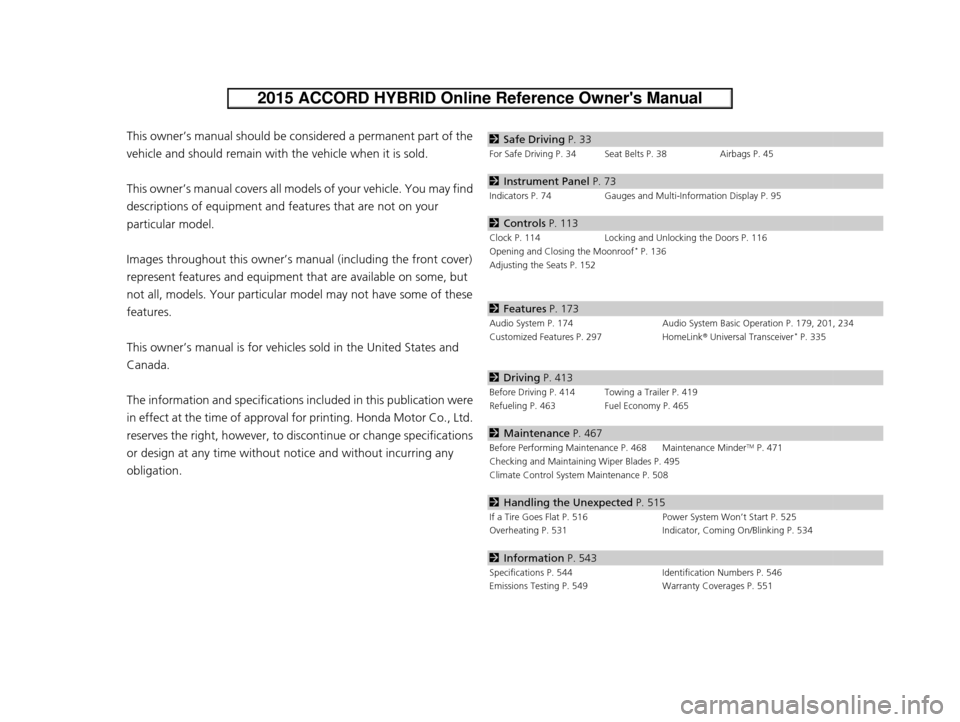
Contents
This owner’s manual should be considered a permanent part of the
vehicle and should remain with the vehicle when it is sold.
This owner’s manual covers all models of your vehicle. You may find
descriptions of equipment and features that are not on your
particular model.
Images throughout this owner’s manual (including the front cover)
represent features and equipment that are available on some, but
not all, models. Your particular mo del may not have some of these
features.
This owner’s manual is for vehicles sold in the United States and
Canada.
The information and specifications in cluded in this publication were
in effect at the time of approval for printing. Honda Motor Co., Ltd.
reserves the right, however, to discontinue or change specifications
or design at any time without notice and without incurring any
obligation.2 Safe Driving P. 33
For Safe Driving P. 34 Seat Belts P. 38 Airbags P. 45
2Instrument Panel P. 73
Indicators P. 74 Gauges and Multi-Information Display P. 95
2Controls P. 113
Clock P. 114 Locking and Unlocking the Doors P. 116
Opening and Closing the Moonroof* P. 136
Adjusting the Seats P. 152
2 Features P. 173
Audio System P. 174 Audio System Basic Operation P. 179, 201, 234
Customized Features P. 297 HomeLink® Universal Transceiver* P. 335
2 Driving P. 413
Before Driving P. 414 Towing a Trailer P. 419
Refueling P. 463 Fuel Economy P. 465
2Maintenance P. 467
Before Performing Maintenance P. 468 Maintenance MinderTM P. 471
Checking and Maintaining Wiper Blades P. 495
Climate Control System Maintenance P. 508
2Handling the Unexpected P. 515
If a Tire Goes Flat P. 516 Power System Won’t Start P. 525
Overheating P. 531 Indicator, Coming On/Blinking P. 534
2Information P. 543
Specifications P. 544 Identification Numbers P. 546
Emissions Testing P. 549 Warranty Coverages P. 551
15 ACCORD FHEV-31T3W6100.book 2 ページ 2014年7月23日 水曜日 午後3時10分
Page 30 of 569
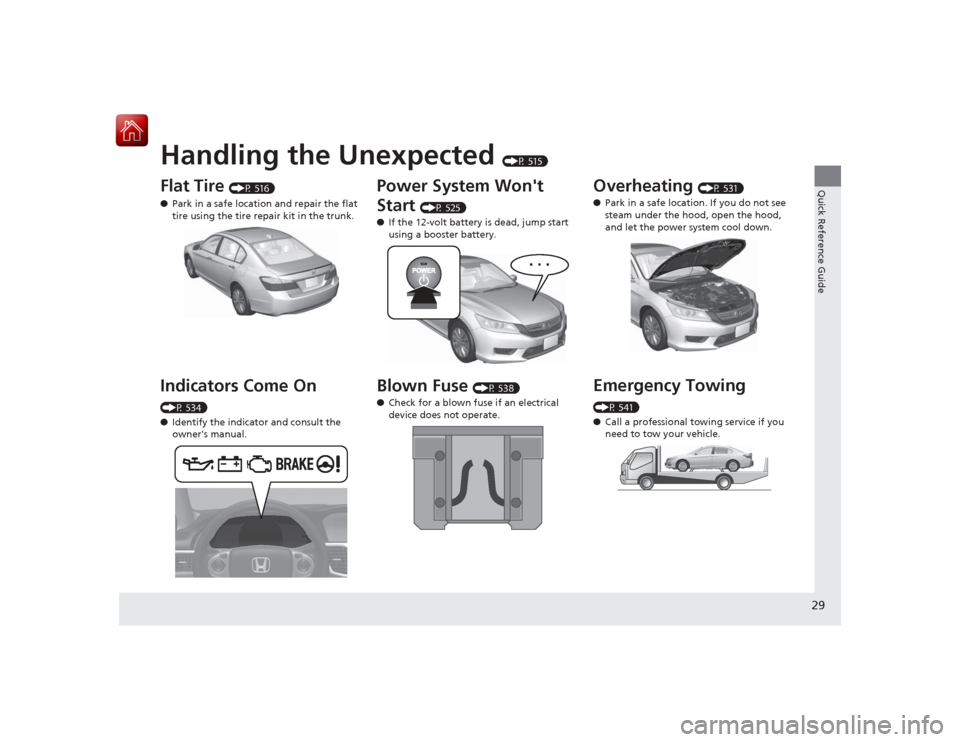
Quick Reference Guide29
Handling the Unexpected
(P 515)
Flat Tire
(P 516)
● Park in a safe location and repair the flat
tire using the tire repair kit in the trunk.
Indicators Come On (P 534)
●Identify the indicator and consult the
owner's manual.
Power System Won't
Start
(P 525)
● If the 12-volt battery is dead, jump start
using a booster battery.
Blown Fuse
(P 538)
● Check for a blown fuse if an electrical
device does not operate.
Overheating
(P 531)
● Park in a safe location. If you do not see
steam under the hood, open the hood,
and let the power system cool down.
Emergency Towing (P 541)
●Call a professional towing service if you
need to tow your vehicle.
Page 87 of 569
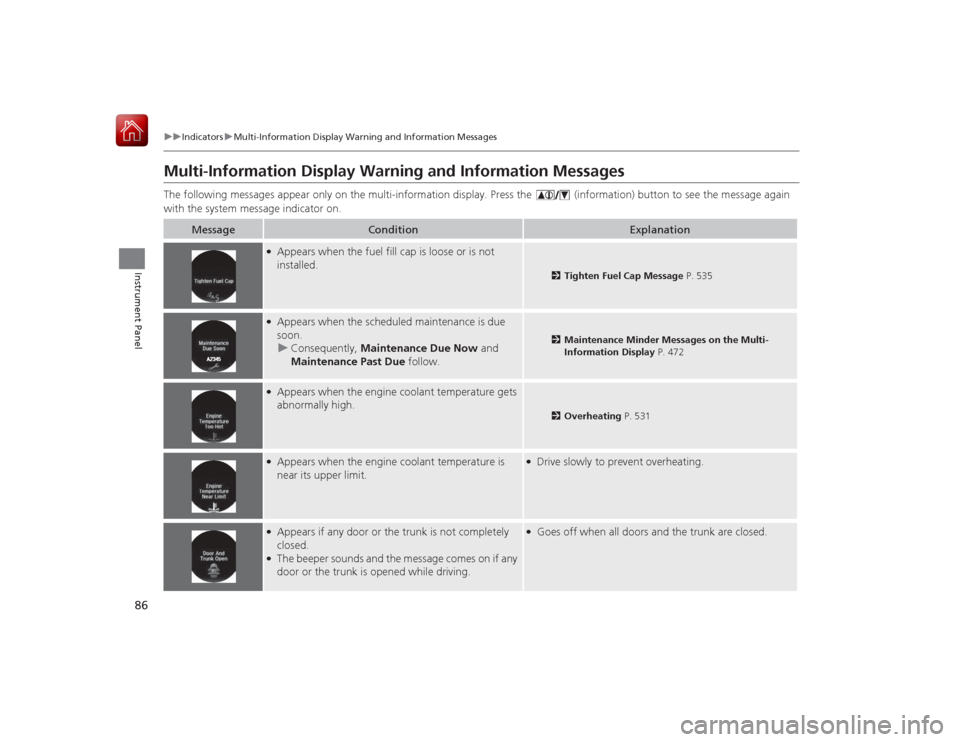
86
uuIndicators uMulti-Information Display Warn ing and Information Messages
Instrument Panel
Multi-Information Display Warning and Information MessagesThe following messages appear only on the multi-information display. Pres s the (information) button to see the message again
with the system message indicator on.
Message
Condition
Explanation
●Appears when the fuel fill cap is loose or is not
installed.
2 Tighten Fuel Cap Message P. 535
●Appears when the scheduled maintenance is due
soon.
u Consequently, Maintenance Due Now and
Maintenance Past Due follow.
2Maintenance Minder Messages on the Multi-
Information Display P. 472
●Appears when the engine coolant temperature gets
abnormally high.
2Overheating P. 531
●Appears when the engine coolant temperature is
near its upper limit.
●Drive slowly to prevent overheating.
●Appears if any door or the trunk is not completely
closed.●The beeper sounds and the message comes on if any
door or the trunk is opened while driving.
●Goes off when all doors and the trunk are closed.
Page 91 of 569
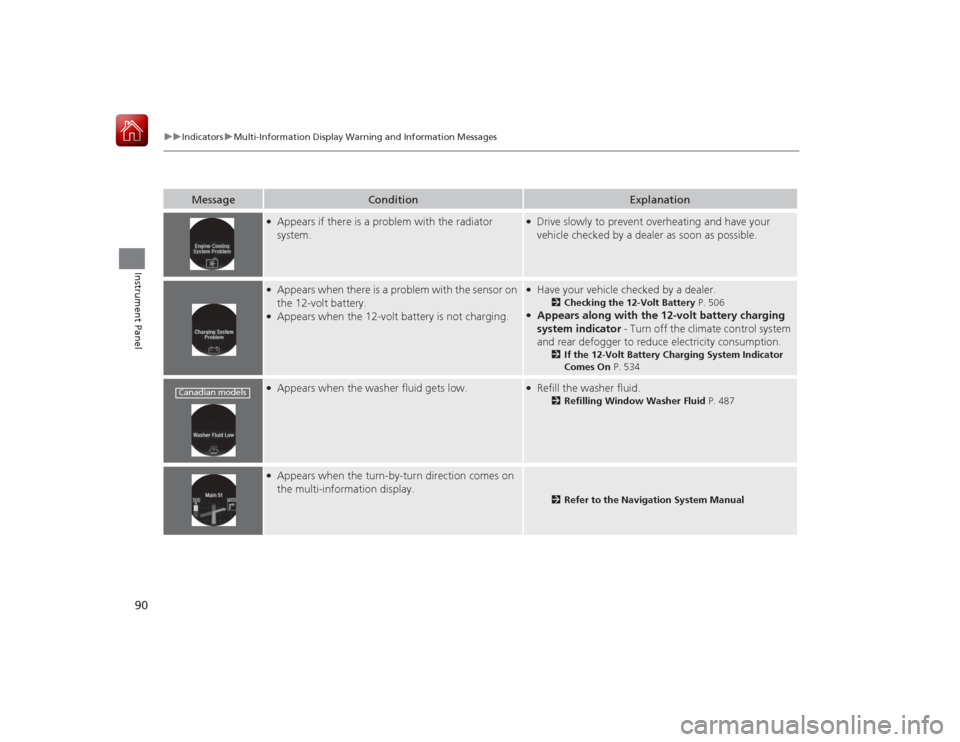
90
uuIndicators uMulti-Information Display Warn ing and Information Messages
Instrument Panel
Message
Condition
Explanation
●Appears if there is a problem with the radiator
system.
●Drive slowly to prevent overheating and have your
vehicle checked by a dealer as soon as possible.
●Appears when there is a problem with the sensor on
the 12-volt battery.●Appears when the 12-volt battery is not charging.
●Have your vehicle checked by a dealer.
2 Checking the 12-Volt Battery P. 506
●Appears along with the 12-volt battery charging
system indicator - Turn off the climate control system
and rear defogger to reduce electricity consumption.
2 If the 12-Volt Battery Charging System Indicator
Comes On P. 534
●Appears when the washer fluid gets low.
●Refill the washer fluid.
2Refilling Window Washer Fluid P. 487
●Appears when the turn-by-turn direction comes on
the multi-information display.
2Refer to the Navigation System Manual
Canadian models
Page 94 of 569
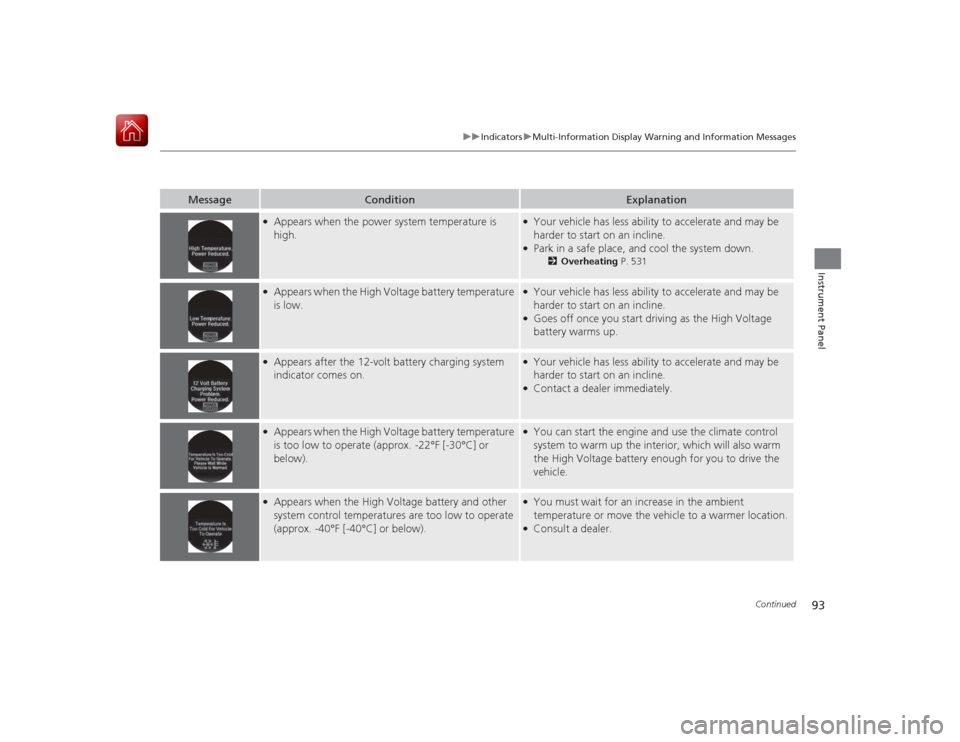
93
uuIndicators uMulti-Information Display Warning and Information Messages
Continued
Instrument Panel
Message
Condition
Explanation
●Appears when the power system temperature is
high.
●Your vehicle has less ability to accelerate and may be
harder to start on an incline.●Park in a safe place, and cool the system down.
2 Overheating P. 531
●Appears when the High Voltage battery temperature
is low.
●Your vehicle has less ability to accelerate and may be
harder to start on an incline.●Goes off once you start driving as the High Voltage
battery warms up.
●Appears after the 12-volt battery charging system
indicator comes on.
●Your vehicle has less ability to accelerate and may be
harder to start on an incline.●Contact a dealer immediately.
●Appears when the High Voltage battery temperature
is too low to operate (approx. -22°F [-30°C] or
below).
●You can start the engine and use the climate control
system to warm up the interior, which will also warm
the High Voltage battery enough for you to drive the
vehicle.
●Appears when the High Voltage battery and other
system control temperatures are too low to operate
(approx. -40°F [-40°C] or below).
●You must wait for an increase in the ambient
temperature or move the vehicle to a warmer location.●Consult a dealer.
Page 498 of 569
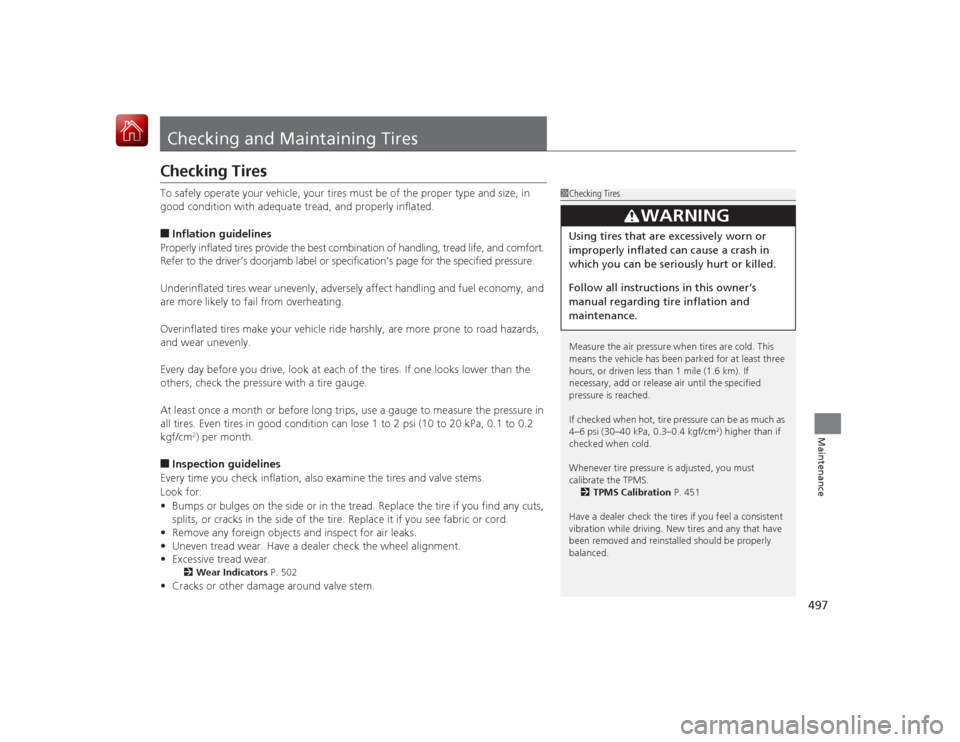
497Maintenance
Checking and Maintaining TiresChecking TiresTo safely operate your vehicle, your tires must be of the proper type and size, in
good condition with adequate tread, and properly inflated.■Inflation guidelines
Properly inflated tires provide the best co mbination of handling, tread life, and comfort.
Refer to the driver’s doorjamb label or specification’s page for the specified pressure.
Underinflated tires wear unevenly, adversely affect handling and fuel economy, and
are more likely to fail from overheating.
Overinflated tires make your vehicle ride harshly, are more prone to road hazards,
and wear unevenly.
Every day before you drive, look at each of the tires. If one looks lower than the
others, check the pressure with a tire gauge.
At least once a month or before long trips, use a gauge to measure the pressure in
all tires. Even tires in good condition can lose 1 to 2 psi (10 to 20 kPa, 0.1 to 0.2
kgf/cm
2) per month.
■Inspection guidelines
Every time you check inflation, also examine the tires and valve stems.
Look for:
• Bumps or bulges on the side or in the tread. Replace the tire if you find any cuts,
splits, or cracks in the side of the tire. Replace it if you see fabric or cord.
• Remove any foreign objects and inspect for air leaks.
• Uneven tread wear. Have a dealer check the wheel alignment.
• Excessive tread wear.2 Wear Indicators P. 502
•Cracks or other damage around valve stem.
1Checking Tires
Measure the air pressure when tires are cold. This
means the vehicle has been par ked for at least three
hours, or driven less than 1 mile (1.6 km). If
necessary, add or release air until the specified
pressure is reached.
If checked when hot, tire pressure can be as much as
4–6 psi (30–40 kPa, 0.3–0.4 kgf/cm
2) higher than if
checked when cold.
Whenever tire pressure is adjusted, you must
calibrate the TPMS. 2 TPMS Calibration P. 451
Have a dealer check the tires if you feel a consistent
vibration while driving. New tires and any that have
been removed and reinstalled should be properly
balanced.
3
WARNING
Using tires that are excessively worn or
improperly inflated can cause a crash in
which you can be seri ously hurt or killed.
Follow all instruc tions in this owner’s
manual regarding tire inflation and
maintenance.
Page 516 of 569
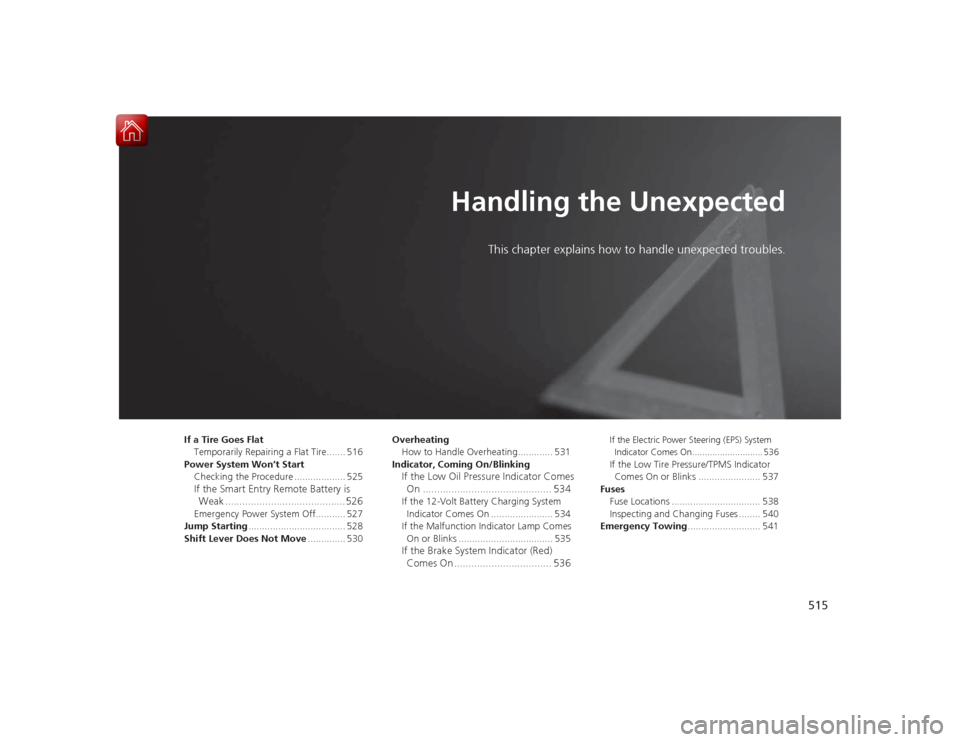
515
Handling the Unexpected
This chapter explains how to handle unexpected troubles.
If a Tire Goes Flat
Temporarily Repairing a Flat Tire....... 516
Power System Won’t Start Checking the Procedure ................... 525If the Smart Entry Remote Battery is Weak .......................................... 526Emergency Power System Off........... 527
Jump Starting .................................... 528
Shift Lever Does Not Move .............. 530Overheating
How to Handle Overheating............. 531
Indicator, Coming On/Blinking
If the Low Oil Pressure Indicator Comes On ............................................. 534If the 12-Volt Battery Charging System
Indicator Comes On ....................... 534
If the Malfunction Indicator Lamp Comes On or Blinks ................................... 535If the Brake System Indicator (Red) Comes On ........................... ....... 536
If the Electric Power Steering (EPS) System
Indicator Comes On............................ 536If the Low Tire Pressure/TPMS Indicator Comes On or Blinks ....................... 537
Fuses Fuse Locations ................................. 538
Inspecting and Changing Fuses ........ 540
Emergency Towing ........................... 541
Page 532 of 569
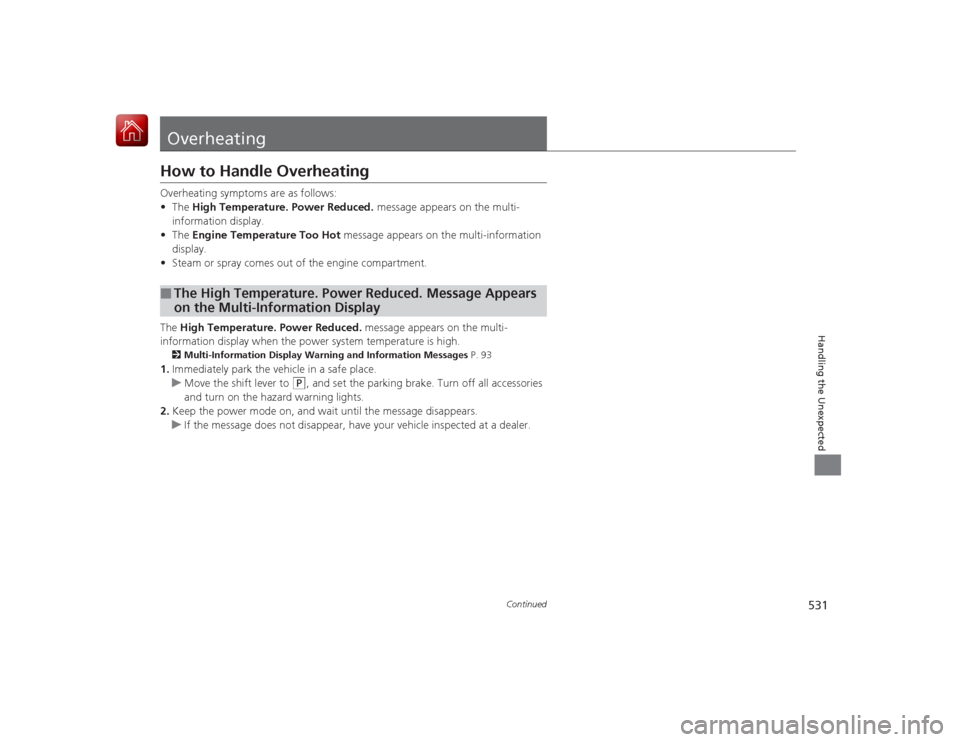
531
Continued
Handling the Unexpected
OverheatingHow to Handle OverheatingOverheating symptoms are as follows:
•The High Temperature. Power Reduced. message appears on the multi-
information display.
• The Engine Temperature Too Hot message appears on the multi-information
display.
• Steam or spray comes out of the engine compartment.
The High Temperature. Power Reduced. message appears on the multi-
information display when the power system temperature is high.2 Multi-Information Display Warning and Information Messages P. 931.Immediately park the vehicle in a safe place.
u Move the shift lever to
(P
, and set the parking brake. Turn off all accessories
and turn on the hazard warning lights.
2. Keep the power mode on, and wait until the message disappears.
u If the message does not disappear, have your vehicle inspected at a dealer.
■
The High Temperature. Power Reduced. Message Appears
on the Multi-Information Display
Page 533 of 569

uuOverheating uHow to Handle Overheating
532Handling the Unexpected
■First thing to do
1. Immediately park the vehicle in a safe place.
2. Turn off all accessories and turn on the hazard warning lights.
u No steam or spray present: Keep the power system on and open the hood.
u Steam or spray is present: Turn off the power system and wait until it
subsides. Then open the hood.■
The Engine Temperature Too Hot Message Appears on the
Multi-Information Display
1 The Engine Temperature Too Hot Message Appears on the Multi-Information DisplayNOTICEContinuing to drive with the Engine Temperature
Too Hot message on the multi-information display
may damage the engine.
3
WARNING
Steam and spray from an overheated
engine can seriously scald you.
Do not open the ho od if steam is coming
out.
Page 534 of 569
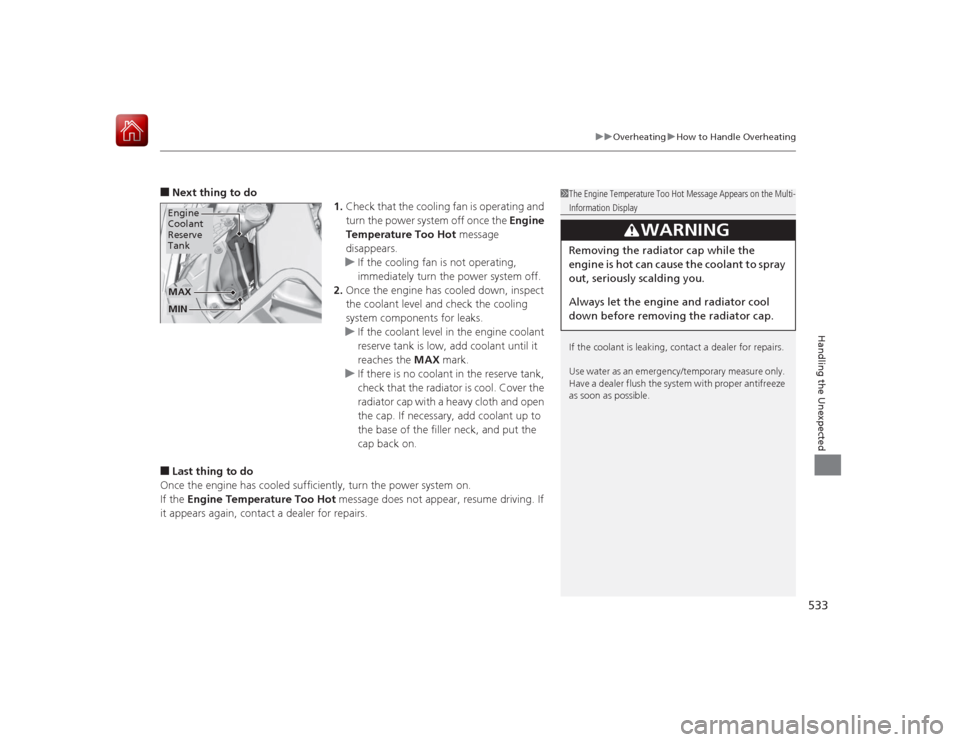
533
uuOverheating uHow to Handle Overheating
Handling the Unexpected
■Next thing to do
1.Check that the cooling fan is operating and
turn the power system off once the Engine
Temperature Too Hot message
disappears.
u If the cooling fan is not operating,
immediately turn the power system off.
2. Once the engine has cooled down, inspect
the coolant level and check the cooling
system components for leaks.
u If the coolant level in the engine coolant
reserve tank is low, add coolant until it
reaches the MAX mark.
u If there is no coolant in the reserve tank,
check that the radiator is cool. Cover the
radiator cap with a heavy cloth and open
the cap. If necessary, add coolant up to
the base of the filler neck, and put the
cap back on.■Last thing to do
Once the engine has cooled sufficiently, turn the power system on.
If the Engine Temperature Too Hot message does not appear, resume driving. If
it appears again, contact a dealer for repairs.
1 The Engine Temperature Too Hot Message Appears on the Multi-Information Display
If the coolant is leaking, contact a dealer for repairs.
Use water as an emerge ncy/temporary measure only.
Have a dealer flush the system with proper antifreeze
as soon as possible.
3
WARNING
Removing the radiator cap while the
engine is hot can cause the coolant to spray
out, seriously scalding you.
Always let the engine and radiator cool
down before removing the radiator cap.
Engine
Coolant
Reserve
TankMAXMIN